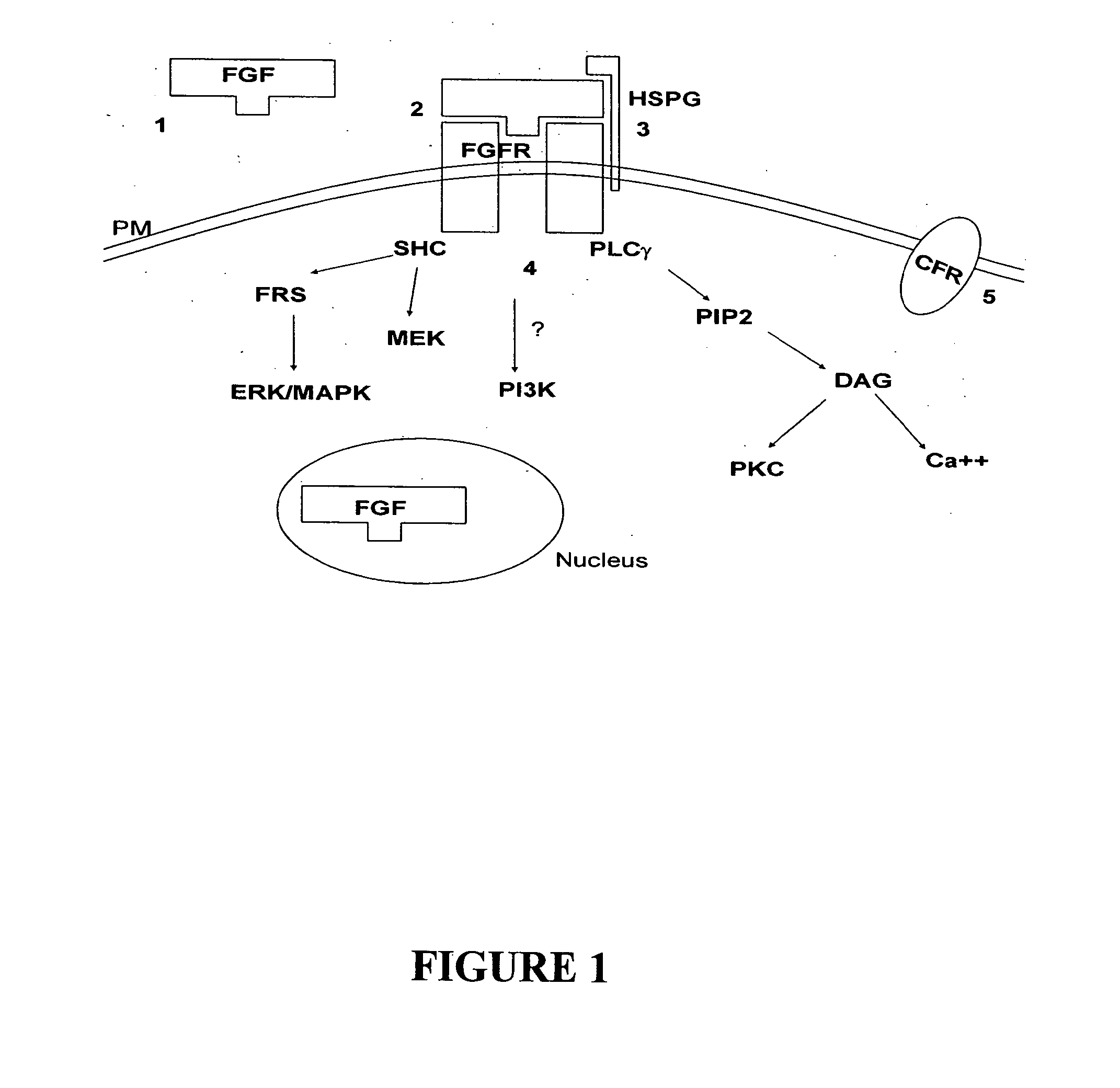Differentiation modulating agents and uses therefor
a technology of differentiation potential and differentiation potential, applied in the direction of peptide/protein ingredients, drug compositions, metabolic disorders, etc., can solve the problems of releasing fgf, relatively inefficient process, limited success of strategies, etc., and achieve the function of fgfr, reduce the expression of genes, and increase the expression of genes
- Summary
- Abstract
- Description
- Claims
- Application Information
AI Technical Summary
Benefits of technology
Problems solved by technology
Method used
Image
Examples
example 1
Biopsy, Isolation and Culture of Human Preadipocytes and MVEC
[1821]Materials and Methods
[1822]Production of Anti-PECAM-1 Antibody-Coated Magnetic Beads
[1823]Dynabeads M-450 with covalently bound sheep anti-Mouse IgGl (Dynal) are coated with purified mouse anti-human monoclonal antibody to PECAM-1 (CD31) (PharMingen) as per manufacturer's instructions. Dynabeads coated with anti-PECAM-1 antibody are resuspended and stored sterile at 4° C. in deionised phosphate buffered saline (DPBS)+0.1% BSA at a concentration of 30 mg / mL. Prepared beads remain active for at least 4 months.
[1824]Subjects
[1825]Paired omental (O) and abdominal subcutdneous (S) adipose tissue biopsies are obtained from 4 male (average age 69 years, range 66-70 yrs; average BMI 27, range 26-29) and 5 female (average age 55 years, range 39-67 yrs; average BMI 27, range 20-32) patients undergoing elective open-abdominal surgical procedures (either gynecological or vascular surgery). None of the patients had diabetes or se...
example 2
Effects of MVEC on Preadipocyte Proliferation and Differentiation
[1851]To investigate the role of vascular endothelial cell-derived factors on adipogenesis, the inventors examined the effects of culturing preadipocytes in vitro in the presence of growth medium containing microvascular endothelial cell-derived growth factors.
[1852]Materials and Methods
[1853]Methods of obtaining biopsy material, isolation and culture of preadipocytes and MVEC are as per Example 1.
[1854]Preparation of Conditioned Medium.
[1855]Separate cultures of human adipose-derived microvascular endothelial cells (MVEC), human dermal microvascular endothelial cells (CADMEC), and human skin fibroblasts (HSF) —all at confluence on 1% gelatin coated culture ware—are each exposed to EC growth medium (see above) containing 10 ng / mL β-ECGF for 48 hrs at 37° C., 5% CO2. This medium is then collected, filtered using a 0.22 μlow protein binding filter, and stored at −20° C. prior to further use. EC growth medium+10 ng / mL β-E...
example 3
Analysis of FGF-1 Expression in Preadipocytes, Adipocytes and MVEC
[1861]Based on the observation that MVEC produce FGF-1, the investigators performed experiments to examine the role of the specific growth factor FGF-1 in the replication and differentiation of preadipocytes in vitro. The results (data not shown) reveal that preadipocytes grown in the presence of purified FGF-1 from the time of isolation show a similar, but not additive, increase in differentiation potential when compared with preadipocytes cultured in the absence of FGF-1 or other MVEC-derived factors. The investigators then designed experiments to confirm the identity of the FGF-1-producing cells, and to quantitate the FGF-1 mRNA production in the cells identified.
[1862]Materials and Methods
[1863]Biopsies of omental and subcutaneous tissue and isolation of preadipocytes are performed as per the procedures outlined in Example 1.
[1864]Immunofluorescent Labeling of Intracellular FGF-1
[1865]A specific anti-FGF-1 antibod...
PUM
| Property | Measurement | Unit |
|---|---|---|
| weight | aaaaa | aaaaa |
| size | aaaaa | aaaaa |
| concentrations | aaaaa | aaaaa |
Abstract
Description
Claims
Application Information
 Login to View More
Login to View More - R&D
- Intellectual Property
- Life Sciences
- Materials
- Tech Scout
- Unparalleled Data Quality
- Higher Quality Content
- 60% Fewer Hallucinations
Browse by: Latest US Patents, China's latest patents, Technical Efficacy Thesaurus, Application Domain, Technology Topic, Popular Technical Reports.
© 2025 PatSnap. All rights reserved.Legal|Privacy policy|Modern Slavery Act Transparency Statement|Sitemap|About US| Contact US: help@patsnap.com



